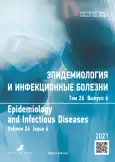Видовой спектр микроорганизмов, выделенных у пациентов госпиталя COVID-19 многопрофильного федерального медицинского учреждения
- Авторы: Петрова Л.В.1,2, Миронов А.Ю.2,3, Гусаров В.Г.1, Камышова Д.А.1, Хакулова А.Э.1, Замятин М.Н.1, Суранова Т.Г.3
-
Учреждения:
- Национальный медико-хирургический центр имени Н.И. Пирогова
- Московский научно-исследовательский институт эпидемиологии и микробиологии имени Г.Н. Габричевского
- Академия постдипломного образования Федерального научно-клинического центра специализированных видов медицинской помощи и медицинских технологий
- Выпуск: Том 26, № 6 (2021)
- Страницы: 270-282
- Раздел: ОРИГИНАЛЬНЫЕ ИССЛЕДОВАНИЯ
- URL: https://journals.rcsi.science/1560-9529/article/view/109205
- DOI: https://doi.org/10.17816/EID109205
- ID: 109205
Цитировать
Аннотация
Обоснование. Несмотря на доказанную важность вторичных бактериальных инфекций, влияющих на тяжесть вирусных респираторных заболеваний, их этиология всё ещё недостаточно изучена. Существует пробел в знаниях о природе, частоте и профилях антимикробной устойчивости бактериальных патогенов в нынешней пандемии COVID-19.
Цель исследования — описать видовой спектр микроорганизмов у пациентов госпиталя COVID-19 на базе многопрофильного федерального медицинского учреждения.
Материалы и методы. Получены и обработаны клинические образцы (кровь, отделяемое нижних дыхательных путей, моча, прочие биологические материалы) пациентов с COVID-19, находившихся на лечении в условиях госпиталя COVID-19 на базе многопрофильного федерального медицинского учреждения.
Результаты. В бактериологическую лабораторию поступила 1821 проба биоматериалов от 452 пациентов, микроорганизмы выделены из 620 (38,0%) проб. БÓльшая часть биоматериала была представлена кровью — 35,9% и отделяемым нижних дыхательных путей — 31,7%. В структуре микроорганизмов доминировали Candida albicans — 19,7%, Staphylococcus aureus — 10,2%, Klebsiella pneumoniae — 10,1%, Enterococcus faecalis — 7,9%. В начале периода работы госпиталя наиболее часто идентифицируемыми микроорганизмами были S. aureus и Haemophilus influenzae — 19,7 и 7,9% соответственно, в то время как в заключительном периоде произошла смена спектра микроорганизмов на нозокомиальные ESKAPE-патогены с множественной лекарственной устойчивостью: в структуре доминировал Acinetobacter baumannii — 24,3%. Потребление антибиотиков в стационаре выросло с 18,3 DDD/100 пациенто-дней в 2019 г. до 28,8 DDD/100 пациенто-дней в 2020 г.
Заключение. Выявлена значимая колонизация различных локусов пациентов с COVID-19 грибами рода Candida. Произошла смена микробного спектра возбудителей инфекций от внебольничных (H. influenzae и S. pneumoniae) до нозокомиальных ESKAPE-патогенов с множественной лекарственной устойчивостью. Значимо возросло потребление антибиотиков.
Полный текст
Открыть статью на сайте журналаОб авторах
Людмила Викторовна Петрова
Национальный медико-хирургический центр имени Н.И. Пирогова; Московский научно-исследовательский институт эпидемиологии и микробиологии имени Г.Н. Габричевского
Email: PetrovaLV@pirogov-center.ru
ORCID iD: 0000-0001-6221-9743
SPIN-код: 7042-9620
Россия, Москва; Москва
Андрей Юрьевич Миронов
Московский научно-исследовательский институт эпидемиологии и микробиологии имени Г.Н. Габричевского; Академия постдипломного образования Федерального научно-клинического центра специализированных видов медицинской помощи и медицинских технологий
Email: andy.60@mail.ru
ORCID iD: 0000-0002-8544-5230
SPIN-код: 9225-1560
д.м.н., профессор
Россия, Москва; МоскваВиталий Геннадьевич Гусаров
Национальный медико-хирургический центр имени Н.И. Пирогова
Email: gusarovvg@pirogov-center.ru
ORCID iD: 0000-0002-2900-1459
SPIN-код: 9668-5339
д.м.н., доцент
Россия, МоскваДарья Андреевна Камышова
Национальный медико-хирургический центр имени Н.И. Пирогова
Email: d.a.kamyshova@yandex.ru
ORCID iD: 0000-0003-3084-9294
SPIN-код: 1066-2506
Россия, Москва
Алина Эдуардовна Хакулова
Национальный медико-хирургический центр имени Н.И. Пирогова
Email: alina.khakulova@mail.ru
ORCID iD: 0000-0003-1257-8937
SPIN-код: 3961-2856
Россия, Москва
Михаил Николаевич Замятин
Национальный медико-хирургический центр имени Н.И. Пирогова
Автор, ответственный за переписку.
Email: zamyatinmn@yandex.ru
ORCID iD: 0000-0002-2072-7798
SPIN-код: 5228-8664
д.м.н., профессор
Россия, МоскваТатьяна Григорьевна Суранова
Академия постдипломного образования Федерального научно-клинического центра специализированных видов медицинской помощи и медицинских технологий
Email: suranovatatiana@mail.ru
ORCID iD: 0000-0003-3411-1027
SPIN-код: 7326-5273
к.м.н., доцент
Россия, Москва
Список литературы
- Kannan S., Shaik Syed Ali P., Sheeza A., Hemalatha K. COVID-19 (Novel Coronavirus 2019) — recent trends // Eur Rev Med Pharmacol Sci. 2020. Vol. 24, N 4. P. 2006–2011. doi: 10.26355/eurrev_202002_20378
- Sifuentes-Rodríguez E., Palacios-Reyes D. COVID-19: The outbreak caused by a new coronavirus // Bol Med Hosp Infant Mex. 2020. Vol. 77, N 2. P. 47–53. doi: 10.24875/BMHIM.20000039
- Sharma B., Sreenivasan P., Biswal M., et al. Bacterial coinfections and secondary infections in COVID-19 patients from a tertiary care hospital of northern India: Time to adhere to culture-based practices // Qatar Med J. 2021. N 3. P. 62. doi: 10.5339/qmj.2021.62
- Кузьменков А.Ю., Виноградова А.Г., Трушин И.В., и др. AMRcloud: новая парадигма мониторинга антибиотикорезистентности // Клиническая микробиология и антимикробная химиотерапия. 2019. Т. 21, № 2. С. 119–124. doi: 10.36488/cmac.2019.2.119-124
- Archive of EUCAST tables and documents [интернет]. [дата обращения: 02.09.2022]. Доступ по ссылке: https://www.eucast.org/ast_of_bacteria/previous_versions_of_documents/.
- Wang Y., Wang Y., Chen Y., Qin Q. Unique epidemiological and clinical features of the emerging 2019 novel coronavirus pneumonia (COVID-19) implicate special control measures // J Med Virol. 2020. Vol. 92, N 6. P. 568–576. doi: 10.1002/jmv.25748
- Garcia-Vidal C., Sanjuan G., Moreno-García E., et al.; COVID-19 Researchers Group. Incidence of co-infections and superinfections in hospitalized patients with COVID-19: a retrospective cohort study // Clin Microbiol Infect. 2021. Vol. 27, N 1. P. 83–88. doi: 10.1016/j.cmi.2020.07.041
- Boucher H.W., Talbot G.H., Bradley J.S., et al. Bad bugs, no drugs: no ESKAPE! An update from the Infectious Diseases Society of America // Clin Infect Dis. 2009. Vol. 48, N 1. P. 1–12. doi: 10.1086/595011
- Yu D., Ininbergs K., Hedman K., et al. Low prevalence of bloodstream infection and high blood culture contamination rates in patients with COVID-19 // PLoS One. 2020. Vol. 15, N 11. P. e0242533. doi: 10.1371/journal.pone.0242533
- Карпов О.Э., Гусаров В.Г., Замятин М.Н., и др. Управление антибиотикорезистентностью в стационаре: современные реалии и перспективы // Клиническая микробиология и антимикробная химиотерапия. 2020. Т. 22, № 4. С. 277–286. doi: 10.36488/cmac.2020.4.277-286
- Палагин И.С., Сухорукова М.В., Дехнич А.В., и др.; Исследовательская группа «ДАРМИС-2018». Антибиотикорезистентность возбудителей внебольничных инфекций мочевых путей в России: результаты многоцентрового исследования «ДАРМИС-2018» // Клиническая микробиология и антимикробная химиотерапия. 2019. Т. 21, № 2. С. 134–146. doi: 10.36488/cmac.2019.2.134-146
- Martinez-Guerra B.A., Gonzalez-Lara M.F., de-Leon-Cividanes N.A., et al. Antimicrobial Resistance Patterns and Antibiotic Use during Hospital Conversion in the COVID-19 Pandemic // Antibiotics (Basel). 2021. Vol. 10, N 2. P. 182. doi: 10.3390/antibiotics10020182
- Langford B.J., So M., Raybardhan S., et al. Antibiotic prescribing in patients with COVID-19: rapid review and meta-analysis // Clin Microbiol Infect. 2021. Vol. 27, N 4. P. 520–531. doi: 10.1016/j.cmi.2020.12.018
- Mirzaei R., Goodarzi P., Asadi M., et al. Bacterial co-infections with SARS-CoV-2 // IUBMB Life. 2020. Vol. 72, N 10. P. 2097–2111. doi: 10.1002/iub.2356
Дополнительные файлы











